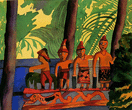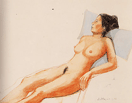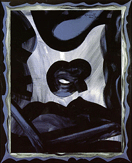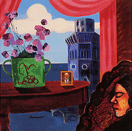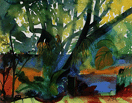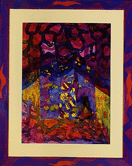FORM & OBSERVATION
By John Russell Taylor, Senior Art Critic of the London Times, 1998
Quite a number of artists are said to be late starters, but I doubt whether any are, except in the most superficial sense. Artistic talent and the artistic urge usually manifest themselves very early, and though circumstances may prevent the budding artist from devoting himself completely to his art, right from achieving adulthood, he has begun as an artist and remains an artist in terms of is responses all the way through until - maybe late in the eyes of the world - he can make a real chance for himself to transmute the evidences of his artist's eye by exercise of his artist's hand.
This has clearly been the case with Jeremy Ramsey. During his school days he was taught by Justin Cox who had among others taught John Minton. Minton later found distinction in the world of art. Cox wrote that he was "far more impressed by Ramsey….than by the work of any other young person in a lifetime as professional artist, including thirty years of teaching". He hope that a grant might make it possible for the boy to go to art school (it did), because "the glint of something other than talent is so rarely sensed that I feel it should be given every change…" Circumstances did not allow Ramsey to pursue the profession of artist after he left art school, but such gifts could not be kept hidden indefinitely.
He took art too seriously to be content with bumbling around as Sunday painter. IF it were to be done, it had to be done with total dedication. And so finally, in his fifties, he could no longer resist taking the plunge, accepting the dedication. What sort of art would emerge from this long period of what Wordsworth called "wise passiveness" must have been excitingly unpredictable. But since Ramsey had been living for many years in the tropics. One might have hazarded a guess that it would be intensely responsive to colour. So infact it has been. It would not take much guesswork to pinpoint a passion for Matisse, the life-affirmer above all others in twentieth-century art. But though there may be occasionally citation, there is no hint of imitation. It sometimes seems that another of painting's most brilliant colourists, Munch, has had his effect also on Ramsey's vision, though his view of the world is far different from Munch's gloomy recognition of a worm in every bud.
But finally, it is Ramsey's own trained responses which dominate, as they should. He is a precise observer: one can see that from the skilled and economical life drawings with their unfeigned artist's delight in the human body. He is fascinated by tropical vegetation, tropical birds, the coolness of the pool, bright blue against the blazing afternoon heat. He appreciates such contrasts. Quite often the paintings depict the outside in terms of the inside: jungle is glimpsed beyond a row of native idols against a window, or rolling hills are seen as a background to a vase a brilliantly hued flowers on a table. Sometimes, though, we are moved totally out into wild nature, and sometimes beyond that again, as the colours and forms take on an independent life of their own, what is observed being boldly abstracted.
Though it is conventional to assume that there is a yawning gulf dividing representation from abstraction, this is very seldom the case in practice. Even the Royal Academy Summer Exhibition has for several years now dropped its convention of segregating the abstractions in a separate room, and just mixed the two freely, so that often the spectator is only hazily aware of when a painting crosses over from, say, landscape to abstract. Many too of the greatest modern painters have seen nothing contradictory about working in both manners. Ben Nicholson constantly moved backwards and forwards throughout his career, frequently engaged in both at the same time. Kandinsky made a gradual transition as recognizable subject-matter - a man on horseback, a medieval wall - was slowly dissolved into pure form.
Ramsey adopts the same sort of approach: it is not so much that he has chosen abstraction as that abstraction has chosen him, making him push his responses to the visual world ever that bit further. By conventional standards he may seem to be late starter, but his art is produced with a pent-up-energy, a head of steam that one could hardly hope to build up in less than forty years.

